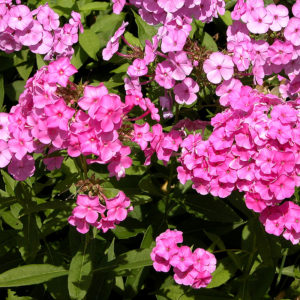Plant Information

Phlox is a genus containing around sixty species in the plant family Polemoniaceae. Phlox consists of both perennial and annual plants that are mostly native to North America. The name phlox comes from the Greek word meaning “flame,” referring to the bright, colorful blooms they can produce.
Phlox are known for their abundance of flowers and are highly attractive to butterflies. Some species are so heavily covered with flowers that it is often hard to see any foliage while they are in bloom. Flower color can be white, pink, red, purple, blue and multicolored. Flowers have five petals and bloom in clusters. Bloom time varies from early spring to mid/late summer. Spring blooming species generally have a shorter blooming period of 2 to 3 weeks, while summer flowering phlox may bloom over several months.
Planting and Maintenance
Phlox will gradually form large clumps where they are growing. In order to prevent plants from becoming congested, divide them every three or four years, in early spring. Replant the clumps around two feet apart. Signs that your phlox plants could need dividing would be fewer flowers and a bare center.
During the growing season, phlox needs about an inch of water each week. Plants should be watered in times of drought or if they begin to wilt in shorter dry spells.
Garden phlox (Phlox paniculata) is the tallest phlox and probably the species that most have in their gardens. It grows in clumps that reach 3 to 5 feet in height and blooms mid to late summer. It is tolerant of most lighting but tends to grow and flower best in areas with partial to full sun.
Annual phlox (Phlox drummondii) is an annual that rarely grows taller than 2 feet tall. Most varieties are not very heat tolerant, but in warmer regions you may find the heat-tolerant varieties for sale. This type of phlox does best in a site that gets partial sun with good drainage.
Creeping phlox (Phlox subulata) is a low-growing species that is a fantastic choice as a ground cover. It spreads slowly and only grows to be 4–6 inches thick. In the spring, creeping phlox can act as a colorful carpet on the ground or when draped over a wall, it could create a waterfall of flowers. Creeping phlox grows best in well-drained soil and partial to full sun.
Economics
According to the USDA NASS Census of Horticulture, phlox sold for a wholesale value of $10.9 million in 2014 and $12.4 million in 2019.
Main Diseases Problems
Powdery mildew is the worst and most common disease of phlox, although resistant varieties are available.
Main Pest Problems
Phlox bugs and spider mites.
IR-4 Research
Most of the research IR-4 has sponsored has been related to crop safety (28 trials and 15 products)
Author
Allison Ballantyne, IR-4 Environmental Horticulture Program Assistant Manager
